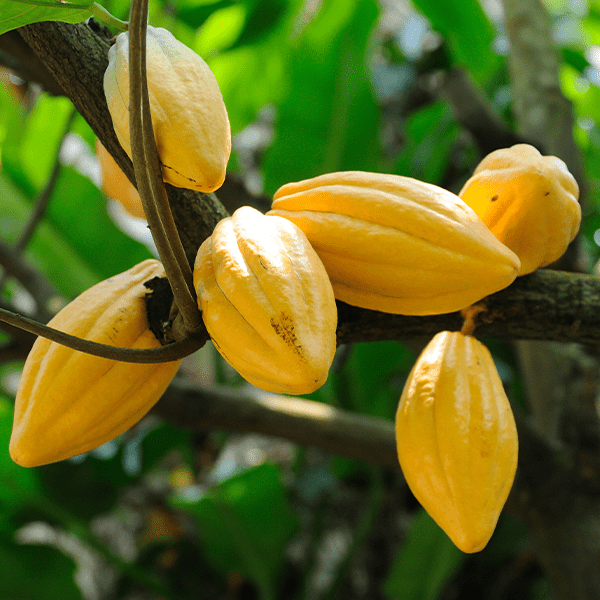800,000 farmers, 6 million people relying on cocoa production… Côte d'Ivoire leads the world in cocoa farming. However, this "brown gold" crop is increasingly threatened by the excessive use of agrochemicals, without health or environmental precautions. Is the future of cocoa in West and Central Africa to be found in a more sustainable agricultural model?
Côte d'Ivoire, the largest cocoa producer in West Africa and the world
Côte d'Ivoire has been the world's leading producer of cocoa for over 20 years. Production is close to 2Mt, or more than 40% of world production. The cocoa sector accounts for 15% of GDP and more than 50% of export earnings according to the World Bank. With a cultivated surface area of 2 Mha, cocoa production in Côte d'Ivoire employs 800,000 farmers and supports 6 million people, a quarter of the Ivorian population.
Côte d'Ivoire is working to improve the productivity, quality and sustainability of its cocoa sector through the 2QC program (quantité, qualité, croissance, i.e. quantity, quality, growth). The continuous improvement of the quality of Ivorian cocoa is the result of good agricultural practices as well as a reinforcement of quality controls. The country also wants to support the local processing of cocoa beans by supporting endeavours such as as the 2015 opening of the CÉMOI cocoa processing plant in Côte d’Ivoire.

Brown rot, endemic disease of cocoa fields in West and Central Africa
Despite this dynamism, pests and diseases cause considerable yield losses in cocoa production, not only in Ivory Coast, but also worldwide. Although there are non-chemical means of controlling them, it is practically impossible to do away with agrochemicals. The risk of brown rot (Phytophthora sp.) on cocoa in most humid areas of central and western Africa may explain the treatments applied shortly before harvest and the high residues in cocoa beans. From the cocoa farmer’s viewpoint, potential harvest losses of more than 80% make these decisions seem right. But it is common for cocoa farmers to buy expired or counterfeit products without being aware of the dangers of using them.
Why do African cocoa farmers need to comply with international SPS standards?
Large cocoa-consuming countries have expressed concerns over the health risks associated with the use of agrochemicals in cocoa growing. Some importing countries have adopted legislative and regulatory measures to establish sanitary and phytosanitary (SPS) standards for cocoa. Cocoa-related food safety issues include pesticide residues, mycotoxins and heavy metals (lead, cadmium).
Failure to abide by pesticide residue regulations published by the European Union (EU), the United States and Japan could disrupt cocoa trade and deprive small cocoa farmers and the government of vital income for the implementation of poverty reduction programs.
It is therefore crucial that cocoa farmers be taught to better comply with international SPS standards. This approach includes awareness of Good Agricultural Practices (GAP) and Good Storage Practices (GEP).
Some ways to grow cocoa by limiting the use of phytosanitary products
In terms of fertilization, mineral fertilization is efficient and profitable only for well-managed fields, meaning fields that are clean, pruned and treated. It is of paramount importance to ensure rigorous hygiene at every stage of the growing process.
The key is to ensure crop protection before and after harvest. This involves alternating methods of agronomic and chemical control as well as the application of a few principles:
- In the case of Phytophthora diseases on cocoa, agronomic control consists of removing affected pods, moving them away from the cocoa plantation and minimizing shading that favors moisture
- At the time of harvest, it is advised to pick the mature pods (three quarters yellow or orange red), to leave out the immature ones (green or red violated) and get rid of rotten pods
- Pod breaking must be carried out no later than 5 days after harvest. For good fermentation, we recommend you put the pods in wooden boxes or under banana leaves for six days.
- At the time of drying and stoking cocoa pods, watch out for excessive humidity. We recommend that the cocoa pods be laid in thin layers (3 to 4 centimeters) on a fixed or mobile rack, on cemented soil, or on a black plastic tarpaulin in order to keep fungi at bay.
Making cocoa farmers aware of these best practices is key to producing cocoa in a safe and sustainable way. Such challenges mean that we must continue to look for innovative, sustainable solutions that respect the environment. Our experts are currently focused on this issue. They are available to assist you with all your cocoa challenges. Please do not hesitate to contact them!
Talk to our experts
Natual is a range of plant-based nutritional supplements designed to support the physiological functions of farm animals and crops, and in particular their natural defences.


